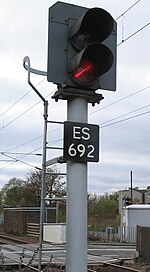Portal:Trains/Selected article/Week 41, 2006
The UK railway signalling system used across the majority of the United Kingdom railway network uses colour light signals to tell the driver the status of the section of track ahead. The main aspects are: red (stop), single yellow (caution, be prepared to stop at the next signal), double yellow (preliminary caution, the next signal is displaying a single yellow aspect) and green (clear, proceed at the highest permitted speed). The single yellow, double yellow and green aspects are known as "proceed aspects" as they allow the train to pass the signal; the red aspect always requires the train to stop. The most common type of four-aspect signal has four lenses arranged from top to bottom as follows: yellow, green, yellow, red. Modern LED signals with just two lenses can show all four aspects. The lower lens is capable of displaying a red, yellow or green light. Not all lines use four-aspect signalling; three or two aspects are used where the headway and line speed allow. The three-aspect version uses three colour lights, omitting the top yellow. The two-aspect version has only the red and green aspects, with distant signals or repeaters (signals that can show only green or yellow) giving advance warning of a red.
Recently selected: EMD F7 - First Transcontinental Railroad - Caledonian Railway

